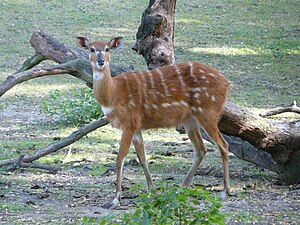Sitatunga
| Sitatunga | ||||||||||||
|---|---|---|---|---|---|---|---|---|---|---|---|---|

Sitatunga ( Tragelaphus spekii ) |
||||||||||||
| Systematics | ||||||||||||
|
||||||||||||
| Scientific name | ||||||||||||
| Tragelaphus spekii | ||||||||||||
| Speke , 1863 |
The sitatunga ( Tragelaphus spekii ), also known as water kudu , swamp goat or swamp antelope , is an African antelope . The sitatunga is the most water-bound antelope species. They live in dense and extensive papyrus marshes and only come to the edge of these thickets in the evening hours to look for food.
Several subspecies are distinguished.
Appearance
Female and male animals can not only be distinguished by their coat color: the adult males are shaggy gray to chocolate brown, females, on the other hand, are bright red-brown to chestnut brown and have white horizontal stripes and speckles on the sides and flanks. The males also have nyala- like horns that can reach a length of up to 92 cm. The shoulder height is 1 m, the head body length 150 cm, the weight 90 kg.
Both sexes have particularly long hooves of 18 cm in length that they can spread; so they are well adapted to their swampy habitat . The Sitatungas occur only in swampy areas with swamps and dense reeds. It spends its life in the papyrus forests and is excellent at swimming. Thus, islands in river and lake landscapes are also accessible to him. Its food is reeds and all kinds of aquatic plants, its enemies are crocodiles, leopards and giant snakes.
distribution
The distribution of the water kudu extends from western to southern Africa. The habitat of the Sitatunga are the landscapes immediately around the rivers and lakes. The watercourses and marshes of the Apoi Creek in the Niger Delta in Nigeria and the Okavango Delta in Botswana are also part of the habitat of this extremely shy antelope species.
Social behavior
Most of these animals live in groups consisting of a buck and one or more females and their offspring, solitary animals also occur. One young is born after a gestation period of 220 days, weaning takes place after about six months, and sexual maturity after two to two and a half years. Although these antelopes are diurnal, during the hottest time of the day they rest on a bed of trampled reeds.
Subspecies
There are 4 subspecies of water kudu. The Forest Sitatunga ( T. s. Gratus ) from Zambia and Botswana, the Zambezi-Sitatunga ( T. s. Selousi ) from Namibia and southeastern Angola and the Eastern Wasserkudu ( T. s. Spekii ) from East Africa. The fourth subspecies, the Sesse-Island-Sitatunga ( T. s. Sylvestris ) occurs only at Lake Victoria in Uganda and is considered threatened.
Surname
The species was described by the Africa explorer John Hanning Speke in a travel report of an expedition to the Nile springs. In a footnote he mentioned that the specific epithet spekii (derived from "Spekius", the Latinized form of the surname Speke) came from Philip Lutley Sclater , but this does not make Sclater the first to describe it according to the rules of the ICZN .
literature
- CA Spinage: The Natural History of Antelopes . Croom Helm, London 1986, ISBN 0-7099-4441-1
Web links
- Tragelaphus spekii inthe IUCN Red List of Threatened Species 2013.1. Listed by: IUCN SSC Antelope Specialist Group, 2008. Retrieved September 27, 2013.
Single receipts
- ↑ Spinage, p. 173


